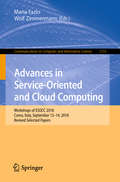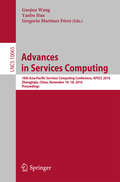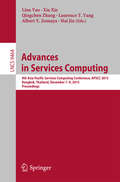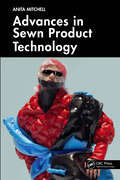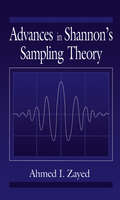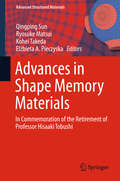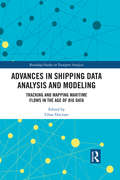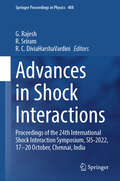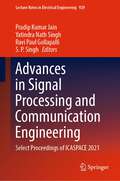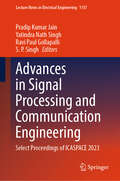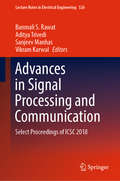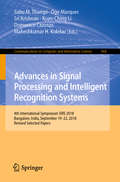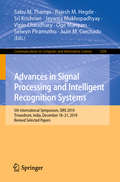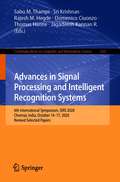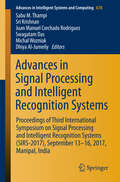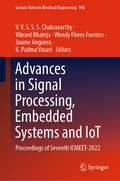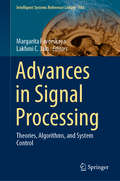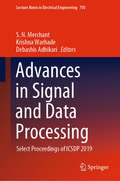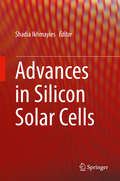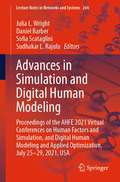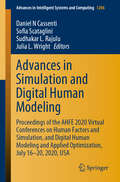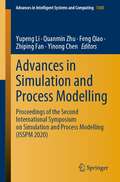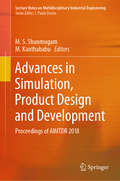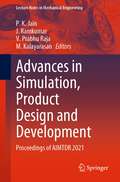- Table View
- List View
Advances in Service-Oriented and Cloud Computing: Workshops of ESOCC 2018, Como, Italy, September 12–14, 2018, Revised Selected Papers (Communications in Computer and Information Science #1115)
by Maria Fazio Wolf ZimmermannThis volume contains the technical papers presented in the workshops, which took place at the 7th European Conference on Service-Oriented and Cloud Computing, ESOCC 2018, held in Como, Italy, in September 2018:Joint Cloudways and OptiMoCS Workshop; 14th International Workshop on Engineering Service-Oriented Applications and Cloud Services. Additionally the papers from ESOCC 2018 PhD Symposium and ESOCC 2018 EU Projects Track were included in the volume. The 22 full papers were carefully reviewed and selected from 34 submissions. The papers focus on specific topics in service-oriented and cloud computing domains such as limits and/or advantages of existing cloud solutions, future internet technologies, efficient and adaptive deployment and management of service-based applications across multiple clouds, novel cloud service migration practices and solutions, digitization of enterprises in the cloud computing era, federated cloud networking services.
Advances in Services Computing: 10th Asia-Pacific Services Computing Conference, APSCC 2016, Zhangjiajie, China, November 16-18, 2016, Proceedings (Lecture Notes in Computer Science #10065)
by Guojun Wang Yanbo Han Gregorio Martínez PérezThis book constitutes the refereed proceedings of the 10th Asia-Pacific Services Computing Conference, APSCC 2016, held in Zhangjiajie, China, in November 2016. The 38 revised full papers presented in this book were carefully reviewed and selected from 107 submissions. The papers cover a wide range of topics in the fields of cloud/utility/Web computing/big data; foundations of services computing; social/peer-to-peer/mobile/ubiquitous/pervasive computing; service-centric computing models; integration of telecommunication SOA and Web services; business process integration and management; and security in services.
Advances in Services Computing: 9th Asia-Pacific Services Computing Conference, APSCC 2015, Bangkok, Thailand, December 7-9, 2015, Proceedings (Lecture Notes in Computer Science #9464)
by Albert Y. Zomaya Lina Yao Xia Xie Qingchen Zhang Laurence T. Yang Hai JinThis book constitutes the refereed proceedings of the 9th Asia-Pacific Services Computing Conference, APSCC 2015, held in Bangkok, Thailand, in December 2015. The 17 revised full papers and 6 short papers presented were carefully reviewed and selected from numerous submissions. The papers cover a wide range of topics in services computing, web services, cloud computing, security in services, and social, peer-to-peer, mobile, ubiquitous and pervasive computing.
Advances in Sewn Product Technology
by Anita MitchellThe fashion industry continues to contribute significantly to greenhouse gas emissions. It is one of the biggest polluters, one of the most wasteful of all global industries and is under increasing pressure to address unsustainable practice. Emerging out of the pandemic era the fashion industry is also responding to a variety of complex industry challenges such as high return rates, customer demand for better fitting apparel, faster fashion, the drive towards personalisation and greater transparency and sustainability across the value chain. These factors along with increasing labour costs are furthermore exerting force on the industry to embrace nearshoring and reshoring. Based on extensive primary research involving oral histories methodology with leading industry professionals involved in the innovation of technological and digital solutions for the fashion industry, this book presents the latest advances in sewn product technology which offer solutions to many of the fashion industry’s current and emerging challenges whilst also informing how these developments are influencing fashion jobs of today and tomorrow. This book is therefore of value to fashion students, academics, researchers, and technicians as well as those working within the fashion industry involved in the design, development, manufacture, buying and retail of fashion apparel.Features: Provides a comprehensive insight into the latest advances in sewing machine technology including advanced automation and robotics used in the manufacture of fashion apparel. Provides a comprehensive insight into the latest industrial sewing threads and needles that can effectively support sustainable design practice. Exclusively covers advances in digital technologies to support sustainable practice including advances in 3D body scanning and digital measuring systems, recent advances in digital pattern making and pattern design systems, recent advances in 3D fashion design software and the latest advances in Product Lifecycle Management (PLM) systems used within the fashion industry. Includes sections on advances in No-Sew Seam Bonding and ultrasonic welding technologies. Provides an insight into advancements in 3D cloth simulation and prototyping for apparel design and gaming. Enables readers to understand the impact of the latest advances in sewn product technology on the jobs of today and tomorrow. Case studies that provide working examples of advances in sewn product technology.
Advances in Shannon's Sampling Theory
by AhmedI. ZayedAdvances in Shannon's Sampling Theory provides an up-to-date discussion of sampling theory, emphasizing the interaction between sampling theory and other branches of mathematical analysis, including the theory of boundary-value problems, frames, wavelets, multiresolution analysis, special functions, and functional analysis. The author not only traces the history and development of the theory, but also presents original research and results that have never before appeared in book form. Recent techniques covered include the Feichtinger-Gröchenig sampling theory; frames, wavelets, multiresolution analysis and sampling; boundary-value problems and sampling theorems; and special functions and sampling theorems. The book will interest graduate students and professionals in electrical engineering, communications, and applied mathematics.
Advances in Shape Memory Materials: In Commemoration of the Retirement of Professor Hisaaki Tobushi (Advanced Structured Materials #73)
by Qingping Sun Ryosuke Matsui Kohei Takeda Elżbieta A. PieczyskaThis book is devoted to the development of the shape memory materials and their applications. It covers many aspects of smart materials. It also describes the method on how we can obtain not only large recovery strains but also high recovery stress, energy storage and energy dissipation in applications. This volume treats the mechanical properties of shape memory alloys, shape memory polymers and the constitutive equations of the materials which are necessary to design the shape memory elements in applications. It also deals with the fatigue properties of materials, the method to design the shape memory elements, and the shape memory composites. The authors are international experts on shape memory alloys and shape memory polymers in the metallurgical, chemical, mechanical and engineering fields. The book will be of interest to graduate students, engineers, scientists and designers who are working in the field of electric and mechanical engineering, industries, medical engineering, aerospace engineering, robots, automatic machines, clothes and recycling for research, design and manufacturing.
Advances in Shipping Data Analysis and Modeling: Tracking and Mapping Maritime Flows in the Age of Big Data (Routledge Studies in Transport Analysis)
by César DucruetShipping flows – maritime ‘footprints’ – remain underexplored in the existing literature despite the crucial importance of freight transport for global trade and economic development. Additionally, decision-makers lack a comprehensive view on how shipping flows can be measured, analyzed, and mapped in order to support their policies and strategies. This interdisciplinary volume, drawing on an international cast-list of experts, explores a number of crucial issues in shipping data estimation, construction, collection, mining, analysis, visualization, and mapping. Advances in Shipping Data Analysis and Modeling delivers several key messages. First, that in a world of just-in-time delivery and rapid freight transit, it is important to bear in mind the long-term roots of current trends as well as foreseeable future developments because shipping patterns exhibit recurrent, if not cyclical and path-dependent, dynamics. Second, shipping flows are currently often understood at the micro-level of intra-urban logistics delivery and at the national level using commodity flow analyses, but this volume emphasizes the need to expand the scale of analysis by offering new evidence on the changing distribution of global and international shipping flows, based on actual data. Third, that this multidisciplinary approach to shipping flows can shed important light on crucial issues that go beyond shipping itself including climate change, urban development, technological change, commodity specialization, digital humanities, navigation patterns, international trade, and regional growth. Edited by experts in their field, this volume is of upmost importance to those who study industrial economics, shipping industries and economic and transport geography.
Advances in Shock Interactions: Proceedings of the 24th International Shock Interaction Symposium, SIS-2022, 17-20 October, Chennai, India (Springer Proceedings in Physics #408)
by G. Rajesh R. Sriram R. C. DiviaHarshaVardiniThis book is a collection of the technical papers presented in the 24th International Shock Interaction Symposium. The main topics include• Shock wave diffraction• Shock wave reflections and refraction on interfaces• Shock wave-boundary layer interaction• Shock wave-shear layer interaction• Shock wave-vortex interaction• Shock wave-bubble interaction• Shock wave-contact surface interaction• Shock wave diffraction over bodies or obstacles• Shock waves in rarefied flows• Shock waves in MHD flows• Dynamics of the explosion, blast waves, and detonations• Shock wave propagation in condensed and heterogeneous materials• Shock waves in high-enthalpy facilities• High-speed flow diagnostics
Advances in Shoulder Surgery
by Eiji Itoi Kazuya Tamai Kenji TakagishiWith critical insights into anatomy and the latest science and research underlying pathogenesis, this book serves as a practical and richly illustrated step-by-step comprehensive guide to successfully performing shoulder surgery, and other related procedures. Abundant diagnostic and treatment approaches including arthroscopy are provided, and are intended to assist beginning and experienced orthopedic surgeons to further develop their skills and facilitate the management of patients with both acute and chronic shoulder injuries. The book provides full-color photos and diagrams to clearly demonstrate operative techniques and tools for surgery. Edited and written by pioneering researcher and surgeons, Advances in Shoulder Surgery offers a valuable guide to recent advances in shoulder surgery and treatment.
Advances in Signal Processing and Communication Engineering: Select Proceedings of ICASPACE 2021 (Lecture Notes in Electrical Engineering #929)
by S. P. Singh Pradip Kumar Jain Yatindra Nath Singh Ravi Paul GollapalliThis book comprises select proceedings of the International Conference on Advances in Signal Processing and Communication Engineering (ICASPACE 2021). The book covers several theoretical and mathematical approaches addressing day-to-day challenges in signal, image, and speech processing and advanced communication systems. It primarily focuses on effective mathematical methods, algorithms, and models that enhance the performance of existing systems. The topics covered in the book are advances in signal processing (radar and biomedical), image processing, speech processing, technical and environmental challenges in 5G technology, and strategies for optimal utilization of resources to improve the efficacy of the communication systems in terms of bandwidth and radiating power, etc. The works published in the book will remarkably be helpful to prospective scholars, academicians, and students seeking knowledge in signal processing and communication engineering.
Advances in Signal Processing and Communication Engineering: Select Proceedings of ICASPACE 2023 (Lecture Notes in Electrical Engineering #1157)
by S. P. Singh Pradip Kumar Jain Yatindra Nath Singh Ravi Paul GollapalliThis book comprises select proceedings of the International Conference on Advances in Signal Processing and Communication Engineering (ICASPACE 2023). The book covers several theoretical and mathematical approaches addressing day-to-day challenges in signal, image, and speech processing and advanced communication systems. It primarily focuses on effective mathematical methods, algorithms, and models that enhance the performance of existing systems. The topics covered in the book are advances in signal processing (radar and biomedical), image processing, speech processing, technical and environmental challenges in 5G technology, and strategies for optimal utilization of resources to improve the efficacy of the communication systems in terms of bandwidth and radiating power, etc. The works published in the book will remarkably be helpful to prospective scholars, academicians, and students seeking knowledge in signal processing and communication engineering.
Advances in Signal Processing and Communication: Select Proceedings of ICSC 2018 (Lecture Notes in Electrical Engineering #526)
by Banmali S. Rawat Aditya Trivedi Sanjeev Manhas Vikram KarwalThis book is a collection of selected peer-reviewed papers presented at the International Conference on Signal Processing and Communication (ICSC 2018). It covers current research and developments in the fields of communications, signal processing, VLSI circuits and systems, and embedded systems. The book offers in-depth discussions and analyses of latest problems across different sub-fields of signal processing and communications. The contents of this book will prove to be useful for students, researchers, and professionals working in electronics and electrical engineering, as well as other allied fields.
Advances in Signal Processing and Intelligent Recognition Systems: 4th International Symposium SIRS 2018, Bangalore, India, September 19–22, 2018, Revised Selected Papers (Communications in Computer and Information Science #968)
by Oge Marques Kuan-Ching Li Sabu M. Thampi Sri Krishnan Domenico Ciuonzo Maheshkumar H. KolekarThis book constitutes the refereed proceedings of the 4th International Symposium on Advances in Signal Processing and Intelligent Recognition Systems, SIRS 2018, held in Bangalore, India, in September 2018.The 28 revised full papers and 11 revised short papers presented were carefully reviewed and selected from 92 submissions. The papers cover wide research fields including information retrieval, human-computer interaction (HCI), information extraction, speech recognition.
Advances in Signal Processing and Intelligent Recognition Systems: 5th International Symposium, SIRS 2019, Trivandrum, India, December 18–21, 2019, Revised Selected Papers (Communications in Computer and Information Science #1209)
by Oge Marques Selwyn Piramuthu Sabu M. Thampi Juan M. Corchado Sri Krishnan Jayanta Mukhopadhyay Rajesh M. Hegde Vipin ChaudharyThis book constitutes the refereed proceedings of the 5th International Symposium on Advances in Signal Processing and Intelligent Recognition Systems, SIRS 2019, held in Trivandrum, India, in December 2019. The 19 revised full papers and 8 revised short papers presented were carefully reviewed and selected from 63 submissions. The papers cover wide research fields including information retrieval, human-computer interaction (HCI), information extraction, speech recognition.
Advances in Signal Processing and Intelligent Recognition Systems: 6th International Symposium, SIRS 2020, Chennai, India, October 14–17, 2020, Revised Selected Papers (Communications in Computer and Information Science #1365)
by Thomas Hanne Sabu M. Thampi Sri Krishnan Domenico Ciuonzo Rajesh M. Hegde Jagadeesh Kannan R.This book constitutes the refereed proceedings of the 6th International Symposium on Advances in Signal Processing and Intelligent Recognition Systems, SIRS 2020, held in Chennai, India, in October 2020. Due to the COVID-19 pandemic the conference was held online. The 22 revised full papers and 5 revised short papers presented were carefully reviewed and selected from 50 submissions. The papers cover wide research fields including information retrieval, human-computer interaction (HCI), information extraction, speech recognition.
Advances in Signal Processing and Intelligent Recognition Systems: Proceedings of Third International Symposium on Signal Processing and Intelligent Recognition Systems (SIRS-2017), September 13-16, 2017, Manipal, India (Advances in Intelligent Systems and Computing #678)
by Swagatam Das Sabu M. Thampi Michal Wozniak Sri Krishnan Juan Manuel Corchado Rodriguez Dhiya Al-JumeilyThis edited volume contains a selection of refereed and revised papers originally presented at the International Symposium on Signal Processing and Intelligent Recognition Systems (SIRS-2014), March 13-15, 2014, Trivandrum, India. The program committee received 134 submissions from 11 countries. Each paper was peer reviewed by at least three or more independent referees of the program committee and the 52 papers were finally selected. The papers offer stimulating insights into Pattern Recognition, Machine Learning and Knowledge-Based Systems; Signal and Speech Processing; Image and Video Processing; Mobile Computing and Applications and Computer Vision. The book is directed to the researchers and scientists engaged in various field of signal processing and related areas.
Advances in Signal Processing, Embedded Systems and IoT: Proceedings of Seventh ICMEET- 2022 (Lecture Notes in Electrical Engineering #992)
by Vikrant Bhateja Jaume Anguera V. V. S. S. S. Chakravarthy Wendy Flores Fuentes K. Padma VasaviThe book discusses the latest developments and outlines future trends in the fields of microelectronics, electromagnetics and telecommunication. It contains original research works presented at the International Conference on Microelectronics, Electromagnetics and Telecommunication (ICMEET 2022), held in Bheemavaram, West Godavari (Dist), Andhra Pradesh, India during 22 – 23 July 2022. The papers were written by scientists, research scholars and practitioners from leading universities, engineering colleges and R&D institutes from all over the world, and share the latest breakthroughs in and promising solutions to the most important issues facing today’s society.
Advances in Signal Processing: Theories, Algorithms, and System Control (Intelligent Systems Reference Library #184)
by Lakhmi C. Jain Margarita FavorskayaThis book attempts to improve algorithms by novel theories and complex data analysis in different scopes including object detection, remote sensing, data transmission, data fusion, gesture recognition, and medical image processing and analysis.The book is directed to the Ph.D. students, professors, researchers, and software developers working in the areas of digital video processing and computer vision technologies.
Advances in Signal and Data Processing: Select Proceedings of ICSDP 2019 (Lecture Notes in Electrical Engineering #703)
by S. N. Merchant Krishna Warhade Debashis AdhikariThis book presents the select peer-reviewed proceedings of the International Conference on Signal and Data Processing (ICSDP) 2019. It examines and deliberates on the recent progresses in the areas of communication and signal processing. The book includes topics on the recent advances in the areas of wired and wireless communication, low complexity architecture of MIMO receivers, applications on wireless sensor networks and internet of things, signal processing, image processing and computer vision, VLSI embedded systems, cognitive networks, power electronics and automation, mechatronics based applications, systems and control, cognitive science and machine intelligence, information security and big data. The contents of this book will be useful for beginners, researchers, and professionals interested in the area of communication, signal processing, and allied fields.
Advances in Silicon Solar Cells
by Shadia IkhmayiesThis book provides a review of all types of silicon solar cells. The scope includes monocrocrystalline Si solar cells, polycrystalline and amorphous thin-film silicon solar cells, and tandem solar cells. Production, treatment and development of these devices are reviewed. Limitations of these devices, design optimization, testing and fabrication methods are covered. In addition, current status and future prospects for the further development of silicon solar cells are addressed. Special emphasis is given to methods of attaining high efficiency and thereby cost-effective solar power. The aim of the book is to provide the reader with a complete overview about the recent advances in the structure and technology of all generations of silicon solar cells.
Advances in Simulation and Digital Human Modeling
by Sofia Scataglini Sudhakar L. Rajulu Julia L. Wright Daniel BarberThis book provides readers with a timely snapshot of modeling and simulation tools, including virtual and mixed-reality environment, for human factors research. It covers applications in healthcare and physical ergonomics, military and transportation systems, industrial monitoring, as well as economics and social sciences. Based on the AHFE 2021 International Conference on Human Factors and Simulation and the AHFE 2021 International Conference on Digital Human Modeling and Applied Optimization, held virtually on 25–29 July, 2021, from USA, the book offers a unique resource for modelling and simulation researchers seeking insights into human factors research and to human factors experts seeking reliable computational tools.
Advances in Simulation and Digital Human Modeling: Proceedings of the AHFE 2020 Virtual Conferences on Human Factors and Simulation, and Digital Human Modeling and Applied Optimization, July 16-20, 2020, USA (Advances in Intelligent Systems and Computing #1206)
by Daniel N Cassenti Sofia Scataglini Sudhakar L. Rajulu Julia L. WrightThis book presents the latest advances in modeling and simulation for human factors research. It reports on cutting-edge simulators such as virtual and augmented reality, multisensory environments, and modeling and simulation methods used in various applications, including surgery, military operations, occupational safety, sports training, education, transportation and robotics. Based on two AHFE 2020 Virtual Conferences such as the AHFE 2020 Virtual Conference on Human Factors and Simulation and the AHFE 2020 Virtual Conference on Digital Human Modeling and Applied Optimization, held on July 16–20, 2020, the book serves as a timely reference guide for researchers and practitioners developing new modeling and simulation tools for analyzing or improving human performance. It also offers a unique resource for modelers seeking insights into human factors research and more feasible and reliable computational tools to foster advances in this exciting field.
Advances in Simulation and Process Modelling: Proceedings of the Second International Symposium on Simulation and Process Modelling (ISSPM 2020) (Advances in Intelligent Systems and Computing #1305)
by Quanmin Zhu Yinong Chen Feng Qiao Yupeng Li Zhiping FanThis book gathers the selected papers from the Second International Symposium on Simulation and Process Modelling (ISSPM 2020), which was held online on August 29-30, 2020, due to COVID-19 pandemic. The Symposium provides a forum in virtual presentation for scholars, researchers and practitioners who are interested in the modelling and simulation of business processes, production and industrial processes, service and administrative processes, and public sector processes to develop theory and practice of simulation and process modelling.
Advances in Simulation, Product Design and Development: Proceedings of AIMTDR 2018 (Lecture Notes on Multidisciplinary Industrial Engineering)
by M. S. Shunmugam M. KanthababuThis volume comprises select proceedings of the 7th International and 28th All India Manufacturing Technology, Design and Research conference 2018 (AIMTDR 2018). The papers in this volume discuss simulations based on techniques such as finite element method (FEM) as well as soft computing based techniques such as artificial neural network (ANN), their optimization and the development and design of mechanical products. This volume will be of interest to researchers, policy makers, and practicing engineers alike.
Advances in Simulation, Product Design and Development: Proceedings of AIMTDR 2021 (Lecture Notes in Mechanical Engineering)
by P. K. Jain J. Ramkumar V. Prabhu Raja M. KalayarasanThis book presents select proceedings of the 8th International and 29th All India Manufacturing Technology, Design and Research Conference (AIMTDR 2021). It covers the recent developments in the areas of product design and development, computer-aided design, computer-aided manufacturing, computer-aided engineering, reverse engineering, modelling and simulation of manufacturing systems, simulation of manufacturing processes, vibration analysis, machine tool design and development, optimization techniques, etc. The contents of this book will be useful for students, researchers and as well as industry professionals in the various fields of mechanical engineering.
